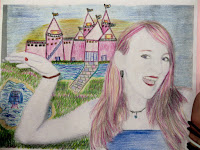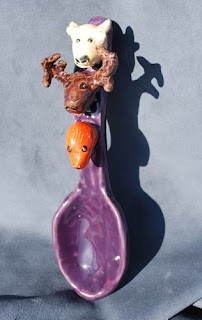 Two girls stood together in front of the tile mural in the main hall after school today. They were much too old to be middle school students, but they looked vaguely familiar. As I walked by, one of the girls reached out and gently traced the line of the horse's mane, "Here's mine!"
Two girls stood together in front of the tile mural in the main hall after school today. They were much too old to be middle school students, but they looked vaguely familiar. As I walked by, one of the girls reached out and gently traced the line of the horse's mane, "Here's mine!""Mine's down here," answered her friend.
"Do you remember your class symbol?"
"Hmmm, this, what is it? Ying Yang, or something like that?"
"Yeah, we did this one." The second girl reached out and traced the circle of a peace sign tile.
The mural, entitled "Terra Firma" was completed and installed four or five years ago. It was a collaborative project integrating social studies and art. Every 7th grade student designed a tile representing an animal from one of the continents. Tiles representing world symbols were added, as well.
Geography lessons covered the ways in which the physical environment effects culture. Art lessons covered tile designs from around the world as well as ways to show animal textures in clay.
I don't know if these two former students remember the lessons, but they certainly remembered the experience and were clearly proud of the mark they'd left behind in their middle school.
































